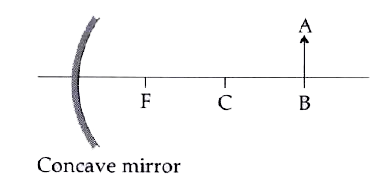To construct a ray diagram, we use two rays which are so chosen that it is easy to know their directions after reflection from the mirror. List two such rays and state the path of these rays after reflection in case of concave mirrors. Use these two rays and draw ray diagram to locate the image of an object placed between pole and focus of a concave mirror.
To construct a ray diagram for a concave mirror when an object is placed between the pole (P) and the focus (F), we will follow these steps:
1. Identify the Components of the Concave Mirror:
- Draw a concave mirror with its principal axis.
- Mark the pole (P), the focus (F), and the center of curvature (C) on the principal axis. The distance from P to F is the focal length (f), and the distance from P to C is twice the focal length (2f).
2. Position the Object:
- Place the object (let's say an arrow) between the pole (P) and the focus (F). Label the object as AB, where A is the top of the object and B is the bottom.
3. Draw the First Ray:
- Draw a ray parallel to the principal axis from the top of the object (point A) towards the mirror.
- After reflecting off the mirror, this ray will pass through the focus (F).
4. Draw the Second Ray:
- Draw a second ray from the top of the object (point A) that goes through the center of curvature (C).
- This ray will reflect back on itself since it hits the mirror at the center of curvature.
5. Extend the Reflected Rays:
- Extend the reflected rays backward (dotted lines) to locate the image. The point where these two extended rays meet is where the image is formed.
6. Locate the Image:
- Mark the point where the extended rays intersect as A'B', which represents the image of the object. This image is virtual, upright, and magnified.
7. Label the Image:
- Label the image as A'B', noting that it is located behind the mirror.
Final Ray Diagram:
- The ray diagram should clearly show the concave mirror, the object (AB), the two incident rays, their paths after reflection, and the location of the image (A'B').
- Draw a concave mirror with its principal axis.
- Mark the pole (P), the focus (F), and the center of curvature (C) on the principal axis. The distance from P to F is the focal length (f), and the distance from P to C is twice the focal length (2f).
- Place the object (let's say an arrow) between the pole (P) and the focus (F). Label the object as AB, where A is the top of the object and B is the bottom.
- Draw a ray parallel to the principal axis from the top of the object (point A) towards the mirror.
- After reflecting off the mirror, this ray will pass through the focus (F).
- Draw a second ray from the top of the object (point A) that goes through the center of curvature (C).
- This ray will reflect back on itself since it hits the mirror at the center of curvature.
- Extend the reflected rays backward (dotted lines) to locate the image. The point where these two extended rays meet is where the image is formed.
- Mark the point where the extended rays intersect as A'B', which represents the image of the object. This image is virtual, upright, and magnified.
- Label the image as A'B', noting that it is located behind the mirror.
- The ray diagram should clearly show the concave mirror, the object (AB), the two incident rays, their paths after reflection, and the location of the image (A'B').
Similar Questions
To construct a ray diagram we use two rays of light which are so chosen that it is easy to determine their directions after reflection from the mirror. Choose these two ras and state the path of these rays after reflection from a concave mirror . Use these two rays to find the nature and position of the image of an object plced at a distance of 15 cm from a concave mirror of focal length 10 cm.
View SolutionCopy and complete the following ray diagram to obtain the image of the object AB kept in front of the concave mirror.
 View Solution
View Solution
Knowledge Check
- Question 1 - Select One
A ray of light after reflection from a mirror is known as
Areflected rayBnormalCincident rayDrefracted ray
A ray of light passing through the focus, after reflection from a concave mirror travels ……….
View SolutionDraw a ray diagram showing the formation of image of a point object by a plane mirror.
View SolutionAssertion: A convex mirror always make a virtual image.
Reason: The ray always diverge after reflection from the convex mirror.View SolutionDraw the following diagram, in which a ray of light is incident on a concave/convex mirror, on your answer sheet . Show the path of this ray, after reflection, in each case.
 View Solution
View SolutionState the direction of incident ray which after reflection from a spherical mirror retraces its path. Give a reason to your answer.
View SolutionIn Figure A, draw the reflected ray from the mirror and refracted ray into the air.
 View Solution
View Solution(a) With the help of a suitable ray diagram, derive the mirror formula for a concave mirror.
View Solution

